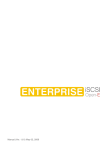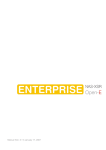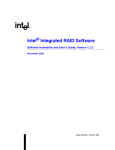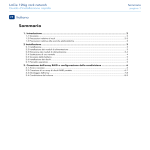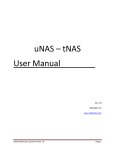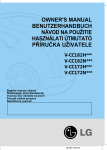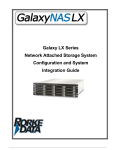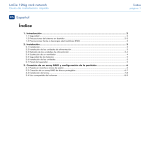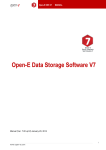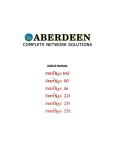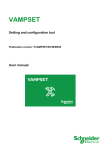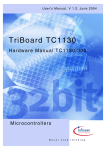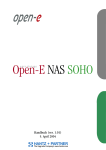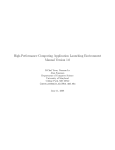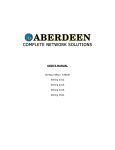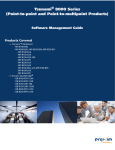Download Manual (Ver. 3.02) September 19, 2006 - Open-E
Transcript
Manual (Ver. 3.02) September 19, 2006 2 1 Before you get started ..............................................................................5 1.1 1.2 1.3 1.4 1.5 1.6 1.7 Content of this package .......................................................................................5 System requirements............................................................................................5 Supported clients .................................................................................................5 Supported network protocols...............................................................................6 Supported network file protocols .........................................................................6 Required tools ......................................................................................................6 Safety precautions................................................................................................6 1.7.1 Personal safety ............................................................................................6 1.7.2 Safety for your data .....................................................................................6 1.7.3 ESD precautions..........................................................................................6 2 Features.....................................................................................................7 2.1 2.2 2.3 2.4 What is NAS ? .......................................................................................................7 Description of the functions..................................................................................7 Why Open-E NAS-XSR? .......................................................................................7 RAID types ............................................................................................................8 3 Hardware installation ................................................................................9 3.1 3.2 Getting ready ........................................................................................................9 Installing Open-E NAS-XSR..................................................................................9 4 Configuration...........................................................................................11 4.1 4.2 4.3 4.4 4.5 4.6 The basic configuration of the NAS-XSR computer...........................................11 First-time operation of Open-E NAS-XSR ..........................................................11 Logging into Open-E NAS-XSR SMB.................................................................12 Create Disk Array................................................................................................14 Adding Disk Array...............................................................................................14 Creating NAS-XSR shares ..................................................................................15 4.6.1 Access to Windows Shares .......................................................................16 4.6.2 Access NAS-XSR Shares under Linux ......................................................17 5 Descriptions of function..........................................................................18 5.1 5.2 Functions of the console display........................................................................18 Functions of Open-E NAS-XSR via browser access..........................................19 5.2.1 Menu “Resources”.....................................................................................19 5.2.1.1 Shares...........................................................................................20 5.2.1.2 User...............................................................................................25 5.2.1.3 Groups ..........................................................................................27 5.2.2 Setup..........................................................................................................27 5.2.2.1 Server............................................................................................27 5.2.2.2 Network.........................................................................................33 5.2.2.3 Administrator.................................................................................34 5.2.2.4 UPS ...............................................................................................37 5.2.2.5 Disk Manager................................................................................37 5.2.2.6 GUI................................................................................................39 5.2.3 Maintenance ..............................................................................................40 5.2.3.1 Shutdown ......................................................................................40 5.2.3.2 Snapshot.......................................................................................41 5.2.3.3 Resources Miscellaneous.............................................................42 5.2.3.4 Software Update ...........................................................................43 5.2.3.5 Antivirus ........................................................................................45 5.2.4 Status .........................................................................................................47 3 5.2.4.1 Network.........................................................................................47 5.2.4.2 Logical Volume .............................................................................48 5.2.4.3 Connections..................................................................................48 5.2.4.4 Hardware ......................................................................................49 5.2.4.5 S.M.A.R.T ......................................................................................51 5.2.5 Raid............................................................................................................53 5.2.5.1 H/W Raid.......................................................................................54 5.2.5.2 S/W RAID ......................................................................................55 5.2.6 Help............................................................................................................58 6 Troubleshooting Guide ...........................................................................61 7 Appendix A ..............................................................................................65 8 Appendix B ..............................................................................................67 4 Copyright (c) 2004 Open-E GmbH. All rights reserved. No part of this publication may be reproduced, stored in a retrieval system, or transmitted in any form, by any means, electronic, mechanical, photocopying, recording or otherwise, without the prior written consent of Open-E GmbH, Lindberghstr. 5, 82178 Puchheim, Germany. Trademarks Open-E and Open-E NAS-XSR logos are all registered trademarks of Open-E GmbH. Windows ((R)), Microsoft ((R)) and Apple ((R)) are registered trademarks in the United States and other countries. Pentium ((R)) and Intel ((R)) are registered trademarks in the United States and other countries. All other trademarks herein are property of their respective owners. Disclaimer Open-E GmbH assumes no responsibility for errors or omissions in this document, and Open-E GmbH does not make any commitment to update the information contained herein. 5 1 Before you get started Congratulations on purchasing Open-E NAS-XSR SMB, the ideal solution for networkbased storage management. This manual will assist you as you install and configure the hardware. In order to quickly reach the desired configuration, please read the following pages thoroughly. The time invested is well spent - after all, you have purchased this solution for your invaluable data. 1.1 Content of this package Before you begin installing Open-E NAS-XSR SMB, make sure that the package contains the following items: • • • • • Open-E NAS-XSR flash module, Power adapter, Quick Start brochure, A CD containing the manual (this document), brochures, images and additional information material, Source CD. If something is missing, please contact your dealer. 1.2 System requirements • • • • • • x86-compatible PC (Pentium III or better), at least 256 MB main memory, IDE port, One or several suitable hard drives, Network Interface Card (NIC), Optionally hardware Raid controller. Open-E NAS-XSR SMB contains its own operating system, no additional software is required. In order to generate maximum performance, we recommend using a network card with 100 MBit/s or more, as well as a processor with at least 1 GHz. If several computers are accessing the NAS-XSR system, we recommend 256 MB main memory or more. 1.3 Supported clients • • • Microsoft Windows (all versions) Linux Mac OS 8.0, 9.0 and OS X 6 1.4 Supported network protocols • • • TCP/IP NetBEUI SNMP 1.5 Supported network file protocols • • • SMB / CIFS / Samba Apple Talk FTP/sFTP 1.6 Required tools • • Grounding strap or mat in order to avoid electrostatic discharge (ESD) Tools for opening the computer’s enclosure (typically, a screwdriver) 1.7 Safety precautions 1.7.1 Personal safety High voltages may occur inside computer equipment. Before removing the enclosure, please turn off the power switch and disconnect the power cords. 1.7.2 Safety for your data If you are not using new hard drives for operating Open-E NAS-XSR, please backup all important data prior to installation. Adding a hard drive to Open-E NAS-XSR goes hand in hand with complete formatting of the hard drive, which can possibly delete existing data. 1.7.3 ESD precautions In order to avoid damage to your computer or to Open-E NAS-XSR, please ensure you are grounded before opening the PC or the ESD package that contains Open-E NAS-XSR. Using grounding straps or mats is the best way to ensure this safety. If you don’t have grounding equipment handy, please make sure you are grounded before working with Open-E NAS-XSR, for instance, by touching a heater. • • Avoid unnecessary touching of the components inside the PC Please touch Open-E NAS-XSR only on the edges 7 2 Features 2.1 What is NAS ? Network Attached Storage (NAS) solutions are defined as storage systems that are directly hooked up to a network infrastructure. Also, they operate independently and do not have to be connected to a server via a controller or host adapter. The term “storage” here generally refers to all systems that either provide data storage or actually store or organize data. Currently, data storage is the most common and most widespread type of NAS systems. NAS solutions are based on a separate operating system (and often also on special hardware), which operates independently from the servers on a network. Typically, this operating system is software that is optimized for providing data (file server). NAS solutions allow users to add additional storage to existing networks quickly, easily, and cost-efficiently. 2.2 Description of the functions Open-E NAS-XSR is one of the easiest ways of implementing an NAS-XSR server in your network. Through its simple architecture – in principal, it is a flash memory with IDE interface and Open-E NAS-XSR as its operating system – Open-E NAS-XSR can be used with all x86 PCs containing an IDE controller and additional SATA Controller on your main board or RAID hardware controller. To start working with Open-E NAS-XSR, all you need to do is assign an IP address to the NAS server – either automatically through an existing DHCP server or by assigning it manually. All other settings are handled via a web front-end which can comfortably be accessed via the IP address of Open-E NAS-XSR using the encrypted https protocol. Open-E NAS-XSR allows users to create so-called shares (i.e., resources within a network that numerous users or user groups have certain access too). The access rights to the shares are controlled through the user and user group settings. 2.3 Why Open-E NAS-XSR? Often, storage in network environments is expanded the following way: File servers have to be shut down in order to install additional drives. In the next step, they need to be reconfigured. In tedious work, data often has to be copied manually onto larger drives, consuming a lot of time and causing costs. With Open-E NAS-XSR, you can add storage to your existing network quickly, easily, and, most important, cost-efficiently. Expensive hardware is, therefore, no longer necessary. Take any computer – a new rack server or an old desktop PC – and 8 exchange the system drive for the Open-E NAS-XSR flash module. To store data, Open-E NAS-XSR uses IDE (ATA) and SATA hard drives, connected to ports on your main board or hardware RAID controller. Additionally NAS-XSR support software RAID, so you can create software RAID over single hard drives or over existing hardware RAIDs. For example, you can create software mirror over two hardware RAID5 for very high reliability. Within a few minutes, you will have up to several hundred gigabytes available on your network – without much effort and any downtime. 2.4 RAID types This manual is not intended to replace your RAID controller manual. But we want to provide you with an overview of common RAID types so that you can make an informed decision on which type to choose. Depending on whom you ask, RAID means either Redundant Array of Independent Disks or Redundant Array of Inexpensive Disks. Both are correct. In essence, you combine the capacity, speed and security of several disks into one. RAID 0 forms one large hard disk by concatenating stripes from each member drive. Stripe size is configurable roughly between 64 KB and 1 MB. The result is a lightningfast RAID, but with no added security. One failing drive may ruin the entire RAID. RAID 1 mirrors hard drives. By writing identical data onto more than one drive, security is enhanced. A completely defective drive does not cause any loss of data. The drawback is reduced performance and capacity. RAID 5 combines data striping from RAID 0 with parity checking, therefore combining speed and improved security. The loss of one drive is tolerable. RAID 10 is a combination of RAID 1 and 0, hence the name. Data is written in a striped and mirrored configuration, providing high performance and robust security. 9 3 Hardware installation 3.1 Getting ready Switch off the computer, remove the power supply, and open the PC's enclosure. In tower cases, the side parts often can be removed individually (on the backside of the enclosure you just need to remove a few screws). Many machines have U- or O shaped covers that have to be pulled off (either towards the front or the back). Should you need any assistance, please contact your dealer. Now localize the IDE connectors on your motherboard: Every motherboard has at least two such ports. To install Open-E NAS-XSR, you have to use the first (primary) port. Often, the labeling on the IDE connectors may be tiny, but it is always there, on each and every board. Preferably look for “IDE 0” If this connector does not exist, the first port is called “IDE 1” (with the second connector being 2). 3.2 Installing Open-E NAS-XSR If necessary, remove the flat band cable which, so far, connected your hard drive with the controller. Open-E NAS-XSR is now carefully inserted into the connector. As IDE ports can have a notch on one side, you can only insert the connector at the preset position. 10 In the package you will find an adapter cable which provides Open-E NAS-XSR with power. The little white plug corresponds with the matching connector on Open-E NASXSR. As a final step, the adapter has to be connected to the white power-supply plug (see photo): That should conclude the installation! Before putting the enclosure on your computer again, do not forget to connect your hard drives to 2nd IDE port or SATA IDE ports . If you have a CD or DVD drive, you can remove it, as Open-E NAS-XSR does not support optical hard drives, but if you want to make an ISO update it is not necessary to remove the CD drives (see 5.2.3.4) 11 4 Configuration 4.1 The basic configuration of the NAS-XSR computer Connect your keyboard and a monitor to the NAS-XSR computer. You will only need those devices for the basic configuration or extended maintenance configuration. You may have to change the function “Halt On: All Errors” in your PC's BIOS, so that the system starts even without the keyboard. The correct configuration is “Halt On: All But Keyboard.” 4.2 First-time operation of Open-E NAS-XSR Now start your system. After booting is complete, Open-E NAS-XSR will provide you with information on the current software version and the network settings: Welcome to Open-E NAS-XSR ----------------------Model: Version: Release date: S/N: Press F1 for Help) Open-E NAS-XSR SMB 3.02.XS00000000.2213 2006-09-19 1357186427 Network settings: interface 1: eth0 ip: 192.168.0.220 Https settings: port allow from 443 all 12 If the network has a DHCP server, Open-E NAS-XSR should gain access to the IP settings automatically. If that is the case, you can proceed at 4.3. If your network does not have a DHCP server, Open-E NAS-XSR will start with the default settings: IP address 192.168.0.220 and subnet mask 255.255.255.0. You can change these values again by typing in the following key combination: left CTRL, left ALT and N. You can select a different IP address now. All other available functions on of the console will appear after pressing F1 key (see below). −−−−−−−−−−−−−−−−−−−−−−−−−−−−−−−−−−−−− Ηelp −−−−−−−−−−−−−−−−−−−−−−−−−−−−−−−−−− You can use below key sequences (C-means ‘Left Ctrl’,A-‘Left Alt’) C-A-N – to edit static IP addresses C-A-P – to restore default factory administrator settings C-A-I – to restore default factory IP configuration C-A-T – to run console tools C-A-X – to display extended tools C-A-H – to display hardware and drivers info F2 - to display all network interface F5 – to refresh console info C-A-S – to shutdown the system −−−−−−−−−−−−−−−−−−−−−−−−−−−−−−−−−−−−−−−−−−−−−−−−−−−−−−−−−−−−−−−−−−−−−− (100 %) −−− < EXIT > −−−−−−−−−−−−−−−−−−−−−−−−−−−−−−−−−−−−−−−−−−−−−−−−−−−−−−−−−−−−−−−−−−−−−−−−−−−−−−−− After a connection has been established, all settings can also be changed remotely via the web browser. If your network require, the address of the standard gateway and the broadcast address can be changed. For additional information, please read the chapter “Functions of the console display.” 4.3 Logging into Open-E NAS-XSR SMB You can establish a connection to Open-E NAS-XSR from every network computer. To establish this connection, use a browser (e.g. Microsoft Internet Explorer) and enter the IP address or the name of the computer hosting the NAS-XSR server into the URL entry line: https://192.168.0.220 (standard address) or https://ancom (this name can be changed in the installation of Open-E NAS-XSR). For security reasons, Open-E NAS-XSR uses the encrypted SSL protocol (https). You will now be asked for verification of the encryption certification. Since Open-E NAS-XSR does not allow for creating shares on the Internet but only on the Intranet, there is no need for global certification by an authorized body. You can accept the certificate for the session only, but also for all future use. Now you have to accept the license in order to use the Open-E software and you can choose the language you want to use. 13 Page with the software agreement and available language option will be shown after first launching Open-E NAS-XSR. Later you can change the language you can change using Language Settings, which are located in “server” through “Setup”. After accepting License agreement you can log into Open-E NAS-XSR using the standard password “ancom” (this can be changed later). In order to start working, you can now set all server parameters. Password checking is case-sensitive. If you cannot log into Open-E NASXSR, please check the status of the Shift and Caps Lock keys. In case your web browser will show something different then expected, please delete the cache & cookies in settings menu of your web browser. 14 4.4 Create Disk Array Use the RAID manager to build a disk array, when a hardware RAID controller is installed in Open-E NAS-XSR. To create disk arrays utilize a 3ware RAID manager (3DM or 3DM2) in case of RAID controllers series 7000/8000. Use an ICP console in case of INTEL / ICP Vortex RAID controllers. For any additional information refer to a RAID controller user manual. If a hardware controller is not installed, you can use software RAID implemented in Open-E NAS-XSR. To create software RAID units, select “RAID” in the menu and then “S/W RAID”. You will find a list of any available disk drives (units). To create a disk array, please mark any selected unit(s) and choose the appropriate RAID from the “destination”. Created RAID units appear as RAID 0, 1 and 5. After clicking “create” a button, the status will change to “in use” with additional information describing the kind of a disk array (e.g. MD0 is RAID 0) 4.5 Adding Disk Array Please select the “Setup” and then the “Disk Manager”. After selecting the “Disk Manager” you will find a list of all logical units (i.e. RAID array). To add a new unit to the NAS, please click “Add”. After a necessary formatting procedure, the status of the unit will change from the “Add” button into “In use”. Please note that you can expand the storage capacity by adding new RAID arrays. In the “Unit Manager” Open-E NAS-XSR will show both ‘In use’ and new unformatted units. 15 Next, with use of function “Logical Volume Manager” you can add disk volume to a new LV, or increase size of existing LV’s (you can’t decrease LV size). To set needed LV size just use scrollbar, next to which, on the right side is shown size available to use. This function can be also used to reserve disk space for “swap” and “snapshots”. Usually for “snapshots” you need about 10% of new Logical Volume. 4.6 Creating NAS-XSR shares In the menu, please select “Setup,” followed by “NAS-XSR server.” Here, you select the type of authentication. In smaller networks, this should be done via the used workgroup name, which has to correspond with the workgroup name of the client PC. 16 In the menu “Resources,” select “Shares” on the right-hand side of the tree diagram. Now create the first share. The workgroup/domain name that was configured in Open-E NAS-XSR has to match with the network settings. Otherwise, the configured shares are not visible in the network environment. If you made changes to the workgroup and server name in Open-E NAS-XSR configuration, it can take some time until each workstation computer in the Windows network detects the new name. 4.6.1 Access to Windows Shares The access to newly created shares is generated via the Windows Explorer. After entering the IP address of your Open-E NAS-XSR (in this example \\192.168.1.2), all visible shares should be available immediately. Please keep in mind that sometimes it takes a few minutes for the new shares or changes to become accessible. When accessing invisible shares, you need to know beforehand the corresponding share name and attach it to the IP address with a backslash (\): 17 4.6.2 Access NAS-XSR Shares under Linux Please use following line to mount an NFS share: • mount -t nfs 192.168.0.220: /share/share_name where: 192.168.0.220 is the Open-E NAS-XSR IP. /local_mount_point Please use following line to mount an SMB share: In a shell: mount -t smbfs -o username=root,password=12345 //192.168.0.220/test /mnt-smb where ‘test’ is the share name In X-windows: Smb://[email protected]/ 18 5 Descriptions of function 5.1 Functions of the console display While Open-E NAS-XSR can be fully administered remotely through a secure Web interface, some of the functions you can access on the console. Open-E NAS-XSR constantly displays following basic parameters: • • IP address Https settings CTRL+ALT+n If you press the left CTRL key + the left ALT key + n, you will be asked for the new IP address and the subnet mask. The DHCP server will be shut down. CTRL+ALT+p If you press the left CTRL key + the left ALT key + p, the access restrictions are lifted by entering the administrator password (in addition, there is a reset to the standard https port 443). CTRL+ALT+i By pressing a combination of left CTRL key, left ALT key and i, you can reset the original IP address (192.168.0.220) and the subnet settings (255.255.255.0). In this process, the DHCP server support is turned on. CTRL+ALT+t By pressing a combination of left CTRL key, left ALT key and t, you can run Console Tools. The menu will appear, with choice of following functions: Ping, DHCP Ping, Hardware info, Memory info, Time configuration and DNS configuration. CTRL+ALT+h By pressing the left CTRL key, left ALT key and h, it will display hardware and driver information. CTRL+ALT+x By pressing the left CTRL key, left ALT key and x, it will display extended tools. F1, F2 and F5 Function key F1 is available to display help information while F5 will reset the console display to default. If you press F2 key all network interface will be displayed. Shutting down and restarting With Ctrl + ALT + DEL the Open-E NAS-XSR host computer will be shut down and restart, while CTRL + ALT + S shut it down. Please be careful with this option when users are connected. 19 5.2 Functions of Open-E NAS-XSR via browser access On the following pages, we will thoroughly describe every function of Open-E NASXSR. The functions are divided by menu options, which are located at the top part of the screen. 5.2.1 Menu “Resources” Here, you can find important data status (IPs, server name, uptime), and you can configure NAS-XSR operations. All that may be accomplished by using tree diagrams on the left side. This will help you manage all shares, users, user groups in a structured manner and in addition control search. The search control can be enabled in the Open-E NAS-XSR menu->setup->GUI in the Search preferences Function. The search control allows to lookup users or groups in the remote or local user database that NAS-XSR server is currently attached to. To apply a criterion put a string into the 'search' textbox and click on the play button. All found entries, containing the search string typed-in, would be listed. Note that the first time you use the search facility, your query will be sent back to the server for processing. All the subsequent searches will access only the locally cached data to save the time. To query the database directly again, set out the 'use cache' checkbox. • • • You can use regular expressions to look for users, for example: to lookup users’ ID beginning with the word 'beg' type ^beg, similarly, append '$' to the string if you want to lookup entries ending with that text, to lookup users or groups ending with 'frog' type-in frog$. By default the search textbox is empty which does not impose any criteria as to what groups or users are shown in the tree. After you hit the play button the first found users/groups will be shown (up to the limit given). Adding elements to the tree can be a time consuming task – especially when the criteria are not tight enough and limit is set up to more than 300 entries. To cancel the operation before it is finished, click on the stop button. 20 5.2.1.1 Shares Here, all shares on your Open-E NAS-XSR are listed. By clicking on the branch “Shares,” with Function “Create new share” you can define a new share or comment it (optional) or set the path. Organized below, you will find all existing shares, which you can edit with a simple click. With the exception of the name, you may alter all parameters. If, however, you must change a name, delete it and assign a new name. Windows users will see the name of the share in the folders of their network environment when they click on the icon for the NAS-XSR server. The comment is only visible if the users take a look at the share properties, or if shares are listed in detail. The path represents the physical location of the data on the share volume of the NAS-XSR server. The user does not know this information. In order to simplify navigation through the directories, you can use the browser function. After clicking “create” button on left page, below on branch shares, will appear the name of earlier established share, in this case “Projects”. Then by clicking on name “Project”, you will see all available functions helpful for setting the share: Function “SMB Settings Function” Shares can be marked as “Read only,” and they can also be hidden (see below). Invisible shares are not displayed in the network environment, but they may still be used. The last parameter is “User access permission”. Either all users can be granted access (even without a password for enabling access to public folders) or only registered users with password. Please note that the entered users (user and password) have to correspond with the Windows login data. 21 In Functions “Users share access (SMB/FTP)” and “Groups share access (SMB/FTP)” you can set the access to the shares to available users and/or groups. Function: “NFS share access” Using this function you activate access to particular share via NFS. In order activate NFS on NAS-XSR server, you must enable usage of NFS in menu setup>NAS-XSR server in Function NFS settings. • • • In order to mount this share via NFS, please use following syntax: mount -t nfs IP_addr:/share/share_name /local_mount_point or mount -t nfs IP_addr:/vol/share_name /local_mount_point Please fill-in the NFS options fields: Allow access IP: Please enter an IP or address range that is allowed to access NFS. You can enter single IP or multiple IP separated with semicolon or IP address range. IP addresses that will not be added to allow write list will have read only access. 22 • • • • • Allow write IP: Please enter an IP or address range that is allowed to write to NFS. You can enter single IP or multiple IP separated with semicolon or IP address range. When you leave allow access IP and allow write IP fields blank, then all computers in subnet will have write access to NFS. When you set allow access and leave allow write IP field blank, then specified computers will have read only access and none will have write access. When you set allow write IP without allow access IP, then specified IPs will have write access and all computers in the subnet will have read only access. • xxx.xxx.xxx.xxx • xxx.xxx.xxx.xxx;xxx.xxx.xxx.xxx; .... • xxx.xxx.xxx.xxx/network_prefix_length. insecure: allows incoming connection to originate from ports > 1024 insecure locks: disables authorization of locking requests, Some NFS clients don't send credentials with lock requests, and hence work incorrectly with secure_locks, in which case you can only lock world-readable files. If you have such clients you can use the insecure_locks option. all squash: Map all users id to nobody user and all groups id to nogroup group. no root squash: Please select this option to grant user root from a client machine, the same level of access to the files on the NAS-XSR server . Otherwise user root from a client machine will be mapped to user nobody on the NAS-XSR server. How to enter Ip address In order to enter specific computers enter the desired IP addresses separated by semicolons, in example: 192.168.0.1; 192.168.0.2; 192.168.0.222; etc. In order to assign the entire address area between 192.168.0.1 and 192.168.0.254 writing privileges enter: 192.168.0.0/24 In order to assign the entire address area between 192.168.0.1 and 192.168.255.254 writing privileges enter: 192.168.0.0/16 There are possible many more combinations. You may find details on IP calculation in Internet. Just search for "ipcalc". For example: 192.168.0.1/28 will set range from 192.168.0.1 to 192.168.0.14 192.168.0.100/29 will set range from 192.168.0.97 to 192.168.0.102 You can easy calculate the network IP range using an IP Address Calculator like: http://www.camtp.uni-mb.si/books/Internet-Book/IP_AddressCalculator.html 23 Function: “FTP Settings” Open-E NAS-XSR allows sharing files over FTP and SFTP protocols. FTP sends users’ IDs, passwords and files over the network as a raw, not encrypted data. SFTP is encrypted FTP and therefore it is much more secure. SFTP allows passwords and files encryption (depending on ftp client configuration). How to share files over FTP? First enable the ftp server. To enable FTP go to “Setup->server->Function: FTP settings”, check “Use FTP” and click the apply button. Next, create/select share that will be accessible over the FTP protocol. Go to the share configuration in “Function: FTP settings” and check “Use FTP” – Anonymous and SFTP modes will appear. 1. Selecting Anonymous mode will enable FTP sharing with anonymous user. For all IPs the access is set to READ+WRITE by default. To change that, activate “Allow access IP” and “Write access IP” options. Clicking apply will make the share available over FTP. 24 To connect to this share FTP client software is required – i.e. Internet Explorer has the FTP support. To connect from IE, enter address ftp://<NAS IP>/pub/, (e.g. ftp://192.168.0.220/pub/). Many FTP client programs need a user name and a password to establish connection. In the Anonymous mode the user name is “anonymous” and there is no password (empty field). All anonymous shares are in the “pub” directory. Any user connecting from the IP without a full access will see all shares but will not be able to see any directories that are prohibited. Anonymous user will see only files and directories that he owns. 2. Selecting SFTP mode will enable secure FTP sharing with the user and password authorization. Only few FTP clients support SFTP, and even fewer SFTP clients support SSL/TLS encryptions. • • • • Here is a list of the tested software: CoreFTP (Windows) FileZilla (Windows) IgloFTP (Windows and Linux) SSLFTP (linux console client) When SFTP is enabled, the user has the access to the share through the authorized user name and password. If the NAS-XSR server uses Windows domain authorization then a short name of the domain must precede a user name – connected with a plus sign, i.e. “DOMAIN+Administrator”. To connect to a share via SFTP in the selected encryption, type in SFTP client NAS support SSL and TLS explicit encryption. All SFTP shares are in the “shares” directory. Users see only the allowed shares. Most FTP clients have bookmarks allowing setting up IP, port home directory, etc. Suggested home directory for the Anonymous is “pub” and for SFTP is “shares”. 25 Function: Synchronize Agent Settings This function allows to set configuration for a synchronization of share. In order to enable synchronization for a share, check box Use synchronization. Its recommended to set Login name, Password and list of Allow access IPs that have access to the share, in another case everyone will have access to the share. Function: Share remove Click "remove" button to remove the share. No data (directories and files) will be deleted on the logical volume. You can re-create deleted share any time. Just go to resources menu, click on shares (as you create new share), then uncheck Create default path box, click on "browse" button then find the folder you want to assign the share. Finally in the field Name please enter your share name and click on "apply" button. Now you will find again the deleted share in your network neighborhood. 5.2.1.2 User In the mode “Workgroup internal LDAP” the category “Users” serves as data entry mask for user accounts. In principal, the process is the same as when you create shares. Enter new users here and assign each of them a name and a password. For security reasons, you have to enter the passwords twice. If users forget their password, there is no way to retrieve it. You can only set a new password. 26 As with all other functions, you open the entire list and select a certain user. In addition, you can remove certain users from the list. In the mode “Windows (PDC)” all users are automatically synchronized with the external server. If you want detailed control over which shares users are allowed to accesses, simply assign the corresponding privileges, or add those users to an already existing user group holding the rights you want to assign to that person. 27 5.2.1.3 Groups In the mode “Workgroup internal LDAP,” you can define entire groups consisting of different users. In addition, you can assign these groups certain access rights. By clicking on “Groups,” a data entry mask opens up, allowing you to create a new group. Assigning the access rights is done the same way as for users (see 5.2.1.2.). In the modes “Workgroup (external LDAP)” and “Windows (PDC)” and “Windows (ADS)” the groups are automatically synchronized with the external server. 5.2.2 Setup In this menu option, you fill find the following sub-functions: Server, Network, Administrator, UPS, Disk Manager und GUI. 5.2.2.1 Server This is a key component of the setup menu, as some of the most crucial parameters are defined here. 28 Function „NAS Server name“ Select a server name that clearly identifies your new server. In the field “Comment,” you can add text describing the function and the location of the PC. Function “Authentication method” You have to select a type of authentication. Options are “Workgroup (internal LDAP)”, “Windows (PDC)” and “Windows (ADS)”. The former is the easiest option – it is suited for beginners or useful for simple storage solutions (e.g. backup servers). The administrator has to create all users in the menu “Resources” and grant them access to the desired shares. Via “Windows (PDC)” and “Windows (ADS)”, the user database is imported from the active directory of a Windows server (with access data provided and with the necessary access rights). The administrator has to fill out the following entry fields: Domain name: Server IP: Name: Password: Entry of the NetBIOS domain name Entry of the Windows server’s IP address Entry of a user name with administrator rights Entry of a password corresponding to the user Changing the authentication method can be a security risk. It is only safe to do that before permissions, quotas and owners are set. In other case, permissions like access to shares, quotas, ACL, can by mixed between users and groups. On NT 4.0 server add NAS Server to Domain a. Run Server Manager program from Menu Start->Programs->Administrative Tools(Common)->Server Manager b. From Server Manager menu select Computer->Add to Domain WARNING: If NAS Server is already added, you must remove it c. In Computer Name field enter NAS Server-Name (NetBIOS name) d. Click Add button Set Windows (PDC) in Open-E NAS-XSR a. b. c. d. From Open-E NAS-XSR web interface choice Setup-> NAS-Server-Setup In Function - Authentication method choose Windows (PDC) option In Server IP field enter NT server IP address In Name & Password fields enter administrator account name and password of NT server e. Click apply button WARNING: If connection fails, the next try you must restart from point a (setting NT) Function: “Clock settings” Here you define an NTP server (Network Time Protocol) to synchronize your Open-E NAS-XSR with a time server on the Internet. 29 Time and date display are static. What is shown are the time and date at which the setup menu was accessed. Function “Set time” With this function, date and time can be entered manually. Alternatively, take the route via an NTP server, which has to be defined in the previous function. Function „NFS settings“ Click "use nfs" to enable access to shares and/or snapshot via NFS. Network File System (NFS) is a protocol for distributed file system which allows a computer to access files over a network as easily as if they were on its local disks. Function “FTP settings” The option to also access NAS via FTP (File Transfer Protocol) offers additional flexibility, as users can access storage either from the Intranet or from the Internet. An FTP client is ideal (e.g., SmartFTP), but the Internet Explorer or a similar browser are also suitable. 30 To enable FTP services check "use ftp". With "port" you provide port the FTP service listens to. Max Clients limits the total number concurrent ftp connections. Max client per host limits the total number connections originating from a single host. Write access to ftp area is granted on per IP basis. If you want to grant write access to a share provide the IP address or the ip address range. You can specify separate addresses - use semicolon as delimiter (e.g. 192.168.1.13; 192.168.1.12 or 192.168.1.0/8 ; 192.168.4.0/8) The option to access Server via FTP (File Transfer Protocol) offers additional flexibility, as users can access storage either from the Intranet or Internet. An FTP client is ideal (e.g., SmartFTP), but the Internet Explorer or a similar browser are also suitable. To establish a connection, the FTP client needs several pieces of data: IP address: 192.168.0.220 (this is the standard address) Port: 21 User: anonymous Password: 123. The allocation of access rights is done via the IP address of the PC currently in the process of accessing. A read access is, therefore, granted with these generally typical and anonymous login data. As a standard, server for FTP uses port 21, which can be changed in the configuration menu (under “Setup” >”server”) If you use the Internet Explorer when accessing, you need to enter the following data into the entry line: ftp://192.168.0.220. You are not prompted to enter the user name and password, as the Internet Explorer first establishes an anonymous connection. If you changed the FTP port, add this information to the entry line the following way: ftp://192.168.0.220:4711 (in this example, 4711 represents the new port number). In order to grant specific computers write access to the FTP area, enter the desired IP addresses into the line "IP address complete access" Function “AppleTalk (AFP) Settings” Here you may activate the AppleTalk protocol in the network. How to use AppleTalk with the Open-E NAS-XSR server: Using the Open-e WEB interface: a. In the “NAS” Server Setup enable AppleTalk. b. In Resources select a share that you want to be shared with Apple Talk. c. Enable AppleTalk for this share. 31 How to connect to the NAS AppleTalk server: In MAC OS 9 a. Open the Chooser (APPLE MENU->Chooser) b. Click on AppleShare c. If the Server “NAS” does not appear in the fileserver list click "Server IP address" d. e. f. g. h. d enter the Open-E NAS-XSR server IP Click “OK” and choose a login type. Enter a user name and password if you want to login as a specified user. From available options select shares that you want to mount. The icon of the mounted share will appear on the desktop. To open the share click on its icon. To unmount the share drop its icon onto the trash. In MAC OSX 10.3. a. Click on the MAC HD, then Applications then Utilities. b. From the Directory Access check if AppleTalk is active; if not -> activate it. c. If the server "NAS" does not appear in the Network list, open a web browser and enter the IP address of the AppleTalk server. afp://192.168.1.3 (very important --> "afp://" ) d. Choose a login type. Enter a user name and password when you want to login as a specific user. e. If you can not log in, click on the Directory Access/Authentication and change the path to search for authentication information. f. From available shares select all you want to mount. g. The icon of any mounted share will appear on the desktop. or second example is: a. Click on "Connect to server" from the Finder (GO submenu). b. Enter: afp://address_ip c. You can add a link to the afp server by clicking on the "+" sign. This adds a link to the computer in the Favorite Servers field. d. Choose a login type, enter a password if you want to login as a specific user. e. From available shares select all you want to mount. f. The icon of the mounted share will appear on the desktop. 32 Function „SMB settings“ • • With this function you can edit SMB protocol specific parameters. There are several options you can change: Wins server IP If you have a WINS server on your network then you should set this to the WINS server's IP Simple and protected negotiation Simple and Protected NEGOtiation (SPNEGO) is a negotiation protocol. If you use PDA Device to access shares on NAS please uncheck it. For connect to your PDA Device use netbiosname, not IP address. • • • Store dos attributes (uses xattrs) This option enables preserving all MS-DOS attributes using Linux xattrs attributes. It cannot be set when you are using option Preserve hidden file attributes or Preserve system file attributes Preserve hidden file attributes and Preserve system file attributes These options enable preserving of MS-DOS attributes: hidden and system. These attributes are mapped to x (EXECUTE) attributes for group and for others in Linux POSIX ACL. Windows ACL permissions are also mapped to Linux attributes. In order to avoid attribute mismatch, it is strongly recommended to disable these options. They cannot be set when you are using Store dos attributes option. Synchronize UID and GID database with NIS server This option allows synchronization UIDs/GIDs between NAS Server and NIS Domain. To have an properly working synchronization please fill: NIS serverdomain name, NIS server IP and Synchronize interval, 33 • Superuser Superuser is a user, who has permission to take ownership of folder and files which belong to other users. It can be useful when administrator want to change access right ( ACL) for folder or file established by other users. Function: Synchronize Agent This function enables Synchronize Agent. This function enables synchronization between two NAS XSR servers, where one and the other can act as a source and destination in the same time. In NAS XSR SMB version, synchronization can be set only as a destination. Shares are available threw Synchronize Agent. Function “Language Settings” English and German are supported. 5.2.2.2 Network Function “IP address” If you want to select an address instead of assigning an IP address automatically via DHCP, you can do it here. It is strongly recommended to use static IP for the server (please uncheck Use DHCP box). If you set new IP address, during activation, you will lose your connection to the server and you will have to log in again. In the URL entry line of your browser, please enter the new IP address. If you do not get access, please try the console to set new IP address. In order to access servers in another subnet, you need to enter the address of a router as Gateway. In case you use NTP server to maintain proper time & date, please make sure you have proper Gateway and DNS settings. 34 5.2.2.3 Administrator Function “Administrator Password” Using this function, you can change the passwords for Open-E NAS-XSR administration accounts. For security reasons, please make sure you change the standard password and select a new one. Three accounts are available by default: Administration (limited access), Maintenance (Enhanced) and Full Access (Maximum Access). Password-checking is case-sensitive. For security reasons, the password you enter will not be displayed. Please check the status of the Shift and Caps Lock keys. Function “Administrator Access” • • • • • Use this function to restrict access to the server administration. Set port: you can change https port (default 443) IP address: you can assign IP addresses (separated by a semicolon) that are allowed to access the Open-E NAS-XSR Web administration. This field left blank means no restriction. Lock console without password: disables access to the console Lock console with password: to get access to the console you need to type in a password. Note that this password should be exactly 8 characters long and include only 1-4 digits. Unlock console: the unrestricted access to the console Please exercise caution with this function when all computers in the network have assigned IP addresses via DHCP: any current IP can be replaced by a new one only after the lease ends. Please use Lock console feature carefully in case of any erroneous IP address settings you will not be able to reset default administrator access from the 35 console. To restore default settings you have to re-update software in the Open-E NAS-XSR module or contact technical support. Function “E-mail notification” In case of significant events, critical errors, warnings, etc., system can send an email to the administrator. Please enter administrator email address. When SMTP server receiving mail, uses the monitoring function of IP numbers, it compares IP number from SMTP server (for example opene.com) with IP number of a computer from which email was sent. This email may be treated as “spam” and will not be accepted. To avoid the above problem, use different SMTP server then the computer currently uses. The best solution for a correct email distribution is to use your local mail server. Function “SSL Certificate Authority” If you want to install Certificate Authority (CA) to your web browser, click on the SSLCert.crt link. Download CA on Desktop, click on it and "Install Certificate". Browser will show you warning, that CA is not trusted and it is normal. Following the instructions, you will install CA to your web server. If you want to delete or view CA go to: Tools->Internet Preferences ÆContent Æ Certificates Æ Trusted Root Certification Authorities and OPEN-E GMBH which should be there. 36 Function “SNMP Settings” • • • • • • • Simple Network Management Protocol (SNMP) is a protocol for monitoring a network and computer equipment. You can monitor: ethernet bandwidth, used memory, used swap, CPU load, SYSTEM load, Uptime, MAC addresses of network card. Default SNMP community is "public" and here you can change it. The community you are setting can be max up to 20 characters. It is for your better security. System location and system contact are only for your information, for example when you connect from SNMP client, you will see your location and name. SNMP is used for synchronization too. For better security use only SNMP 3 version! This version provides login, password and encrypted transmission. How to retrieve information from SNMP ? From Linux: - snmpwalk --> it is command-line tool from snmp-package. You can get information by: snmpwalk -v 3 -u public -l AuthNOPriv -A MD5 -A public123 adres_ip SysUpTime -v3 --> use only 3 version - u public --> community name - A MD5 --> encrypted by MD5 - A public123 --> password address_IP --> IP of NAS-XSR SysUpTime --> OID with system uptime information To use SNMP from command line you have to know OID's, for example: • ssCpu (processor load), mem (memory info), Location. But it is not the best choice to retrieve info from command line. You have to install SNMP client, so you can easily read any information you want. From MS Windows you can use following Windows Clients: PRTG, MIB Browser Professional, SNMP MIB Query Manager and INFTRAF. If you can't retrieve information from SNMP client, you can check NAS_ip/check_sys/index.html. There are SystemLoad, CPU, Memory, Swap and Uptime. 37 5.2.2.4 UPS In the UPS menu you can select a UPS device desired (Uninterrupted Power Supply). For the connection of the UPS device to the NAS-XSR , the USB port is most frequently used. In the settings you can select the UPS model, cable type, connection port and the length of the time out. The time-out defines the time between a power failure and the moment the system will shut down. UPS support 3 modes: Simple means, that Open-E NAS-XSR is the only system attached to this UPS and that there is no action necessary to do remote shutdown for other systems in the network. Master means, that Open-E NAS-XSR is connected to the UPS and sends a signal through the network to shutdown other systems in the network. Slave means, that Open-E NAS-XSR is reacting on a "power down-signal" from an UPS master. During a power failure you cannot log into the Open-E NAS-XSR server. Users who are connected to the Open-E NAS-XSR server during the UPS-time remain full access to all files on the NAS server. 5.2.2.5 Disk Manager Function “Unit Manager“ This function enables you to manage physical storage devices - units (hard drives or raid-arrays). The units can be added to Volume Groups. And then, you can define Logical Volumes in such Volume Group. A new attached unit can be added to a new Volume Group. If a unit is already added to a Volume Group, the status field will show unit as "in use". 38 • • • Disk notations: S0, S1,..., S[x] - every disk with S notation is one of SATA / JBOD / RAID units. H0, H1, ..., H[x] - units with H letter are IDE units. md0, md1,..., md[x] - this way are soft RAIDs denoted. If the unit is already added, it can not be removed. If there is no swap, while adding a new disk a 4GB swap is created. Function “Logical Volume Manager” Using this function you can create a Logical Volume (lv) inside one Volume Group. The Logical Volume is the equivalent of partitions, which this storage space is available for network shares. You can increase capacity of existing Logical Volume. Depending on needed capacity administrator can add more capacity to particular Logical Volume. Using Share Volume/Logical Manager function you can add disk space to new lv, or increase size on existing lv’s (you can’t decrease lv size). To set needed lv size use scrollbar, next to which, on the right side is shown size available to use. 39 This function can be also used to reserve disk space for “snapshots” and “swap”. Usually for “snapshots” you need about 10% of new Logical Volume. The SWAP is an additional disk space used by the system to temporally release some amount of used RAM memory. So, one can reserve some shared disk space for the system SWAP memory. Last time we have added a lot of new features consuming in total some amount of additional memory, so in some cases e.g. 512MB would not be enough and some processes might stop working - the SWAP would prevent. While adding each new Unit there will be 4 GB space reserved for swap (if there is no swap already created). Additionally there is 1 GB space reserved for system internal use. Function “Disk Localizer This function helps find disks in cage in your NAS server. If you connect hard drives to hardware RAID controller then you may not be able to determine which unit is which disk using S.M.A.R.T. tool or hardware RAID management tool (depends on manufacturer of RAID controller). When you click on "start" button then appropriate disk will start reading and you can determine which disk is it by watching "disk-activity LEDs". For proper operation of this function there should be no other activity on hard drives. Localization will stop automatically after one minute if you not stop it before (by unsetting appropriate checkbox and applying form). Using this function during normal operation is highly not recommended and will cause slowing down your server. 5.2.2.6 GUI Function; “Search preferences“ With this function you can enable or disable searching option in “resources” menu. Also you can set up to 500 elements in tree of users or groups 40 5.2.3 Maintenance This page accessed with the Maintenance tab contains settings and functions pertaining to general management operations. 5.2.3.1 Shutdown Function „System shutdown“ When using this function, you can shut down the NAS-XSR server. If any of your users are currently connected, you will be asked to confirm the shutdown. If no users are connected, the process will be executed immediately without any delay. The NAS-XSR server can only be turned on again manually. Function “System Restart” This function is self-explanatory: It allows restarting the system. Function “Connection Reset” When using this function, you can update all network settings including all changes previously made. This function also allows informing all clients directly about any changes made to shares and access rights. All clients will receive the update immediately. Otherwise, it may take several minutes before all clients are informed about any changes. You can choose to reset SMB and/or FTP connection. Disconnecting your users while any files are open may lead to data loss. 41 5.2.3.2 Snapshot Function “Snapshot“ This function allows to manually activate (create) or deactivate (remove) snapshots. Simply push the Create/Remove button. In Open-E NAS-XSR SMB version there is possibility to access this snapshot via SMB or NFS. To make it possible mark proper functions in menu: “setup” Æ “server” options. Function “SMB Snapshot access“ This tool enables adding and removing users who have access to snapshot images. To grant access to snapshot images select a user from the column "Available" and click the appropriate arrow sign. To revoke access to snapshot images from a user select the user from the column "Granted access" and click the appropriate arrow sign. Function “NFS snapshot access” Witch this function you can activate access to the snapshots via NFS. Please click on the box use nfs to activate access to the snapshots via NFS. In order to mount snapshot via NFS, please use following syntax: 42 mount -t nfs IP_addr:/snapshot/1/nas /local_mount_point Please fill-in the NFS options fields: IP Addr: Please enter an IP or address range that is allowed to access NFS. You can enter single IP or multiple IP separated with semicolon or IP address range. • • • xxx.xxx.xxx.xxx xxx.xxx.xxx.xxx;xxx.xxx.xxx.xxx; .... xxx.xxx.xxx.xxx/network_prefix_length. Insecure: allows incoming connection to originate from ports > 1024 5.2.3.3 Resources Miscellaneous The next menu option is “Resources Miscellaneous” This function allows you to save shares, users and groups, to retrieve them, and to remove them. Function “Save resources” With this function you easily store the settings of your resources. System will save the settings in the settings folder on logical volume. You can restore this settings in the future. If you want to have access to the settings via FTP, NFS or Network Neighborhood please create a share "settings" with default path. Function “Restore resources” With this function you restore previously saved settings. Be aware that settings are saved on logical volume in "settings" folder. 43 Function “Remove resources” With "Remove Resources" you remove all resources settings (shares, users and groups and assignments). It is important to point out that this function will not delete the data such as your files or folders. After you have selected the remove function you will be prompted to confirm your choice. The "Remove" button irrevocably deletes resources settings. Please only use this function if you really want to delete all users and resources settings. In case you have saved the resources settings before, you can restore all resource settings back. 5.2.3.4 Software Update This function allows you to update the system software. There are two ways of updating NAS software. 44 1. 2. 3. 4. During updating from share please follow this steps: In resources menu create share "update" with default path. Copy update file into update folder. Press Update button. Confirm update when you will be asked. Some updates need a system restart. In this case you will be informed about needed restart in confirmation message. 1. 2. 3. 4. 5. 6. 7. 8. During update from CD please follow this steps: All existing snapshots should be removed. There might be troubles to access volumes after updating when the snapshots were left on the server. To be sure, that no snapshot is active, please deactivate synchronization as well. Write down the actual NAS server IP address and NAS server name. After having updated NAS, please re-enter both. Write down authorization settings. Before Updating, please save “User”, “Groups”, “Shares” and under Menu: “Maintenance -> Resources Misc -> Save resources”. Download and save NAS Server Logs: Menu “Status -> Hardware” in Function Logs click on “Download”, then save on your local HDD. The ISO-Files which include in update file must be burned on a CD with your favorite Burning software. (For example: Nero Burning ROM - option: “Burn Image”, etc.) In order to re-flash the module, please install CD-ROM as Secondary-Master and DOM (disk-on-module) as Primary-Master. : USB CD-ROM can be used as well. 9. Set the BIOS to boot from CD-ROM drive. 10. Boot from the ISO-CD and wait until prompt: “Update complete, Please Remove CD and restart” 11. After re-fleshing, please reset the BIOS to boot from Primary-master HDD. 45 Updating the system may take about 10 minutes. Please remember that making an update is activity that cannot be stopped in any way. We strongly recommend to update system when UPS is connected. 5.2.3.5 Antivirus Function “Antivirus setup” This function gives Antivirus protection for your data. The feature "quarantine" allows to choose, whether you want to move the infected files to default folder (quarantine_dir), automatically created in shares, or option "manual" witch allows you to choose the place of quarantine, in previously created share (in example share named "Quarantine"). If there is no option "quarantine" you will be only informed about the infected file. To verify the information about the infected files look in logs. You will get the info witch files is infected and with what viruses. Function: Update virus definitions This function allows downloading the antivirus database. Thanks to option "Select mirror" you can choose one of the mirror servers nearest to your localization. • • • • Option "Update interval" allows updating the virus database: Now Now and every hour Now and every 12 hours at 0:00,12:00 Now and every 24 hours at 0:00 For maximum antivirus protection and security we recommend to set the update time every hour. 46 Function: Antivirus scan This function allows you to add shares to antivirus scan. You can run antivirus scan now by selecting "Now" from "Time select" combo box. It is also possible to add scanning to schedule. If you set manual quarantine path then share chosen as quarantine will not be available to scan. 47 Function: Antivirus scan schedule This function allows you to edit previously saved antivirus scan schedules. There are available 2 types of schedule: weekly and interval. Interval: Scan will be made every "selected time". E.g. if you choose interval 1 h. each one hour share will be scanned. Weekly: Scan will be made in selected days at specified time. To edit properties of schedule please click at To delete schedule please click at You can also delete a schedule by setting interval to "not set" or deselecting all days and unset time when using weekly schedule. It is possible to edit time of scans. If you want to edit shares to scan please delete this schedule and add new. It is possible to perform one scan at once. If you schedule few scans at the same time, only one will be done (the rest will be enqueued). 5.2.4 Status This function provides a quick overview of the most important system parameters of your Open-E NAS-XSR. The corresponding sub-functions are network, share volume, connections, and hardware. 5.2.4.1 Network This function gives information on the IP address and the NAS date and time. 48 5.2.4.2 Logical Volume This function contains any statistical data on the share volume, dynamic unit statistic and browse, the synchronization status, the snapshot status and antivirus scan status. 5.2.4.3 Connections This function displays what user connections are currently active. 49 5.2.4.4 Hardware The “Hardware” option provides you with information on storage and network controllers and the drivers (e.g. network driver and RAID driver). 50 In addition, you may also download the latest Open-E NAS-XSR log files, to view specified log file without downloading all log files in compressed form and check memory (RAM) and (SWAP) info usage. 51 5.2.4.5 S.M.A.R.T Through the S.M.A.R.T. system, modern hard disk drives incorporate a suite of advanced diagnostics that monitor the internal operations of a drive and provide an early warning for many types of potential problems. When a potential problem is detected, the drive can be repaired or replaced before any data is lost or damaged. • • Here you can find tree with hard drives for which you can view S.M.A.R.T. information. It is possible to view information about separate hard drive or summary for all drives in the system. To view S.M.A.R.T. information for a hard drive - please click on appropriate drive name. To view summary please click on "all units" 52 Function: S.M.A.R.T. units health status This function allows you to check S.M.A.R.T. status of hard disks. S.M.A.R.T. (Self-Monitoring, Analysis, and Reporting Technology) is a monitoring system for computer hard disks to detect and report on various indicators of reliability, in the hope of anticipating failures. To enable S.M.A.R.T. checks you need to use console tools and enable it in "special options" It will be possible to enable S.M.A.R.T. when all hard disks support it and it is enabled in BIOS settings. When S.M.A.R.T. is enabled you will see all detected hard drives with information if specified drive has passed health checks. To view more information and/or do more advanced test click on drive in drives tree on left side. Function: S.M.A.R.T. info This function allows you to view S.M.A.R.T. parameters which this disk is able to return. In the upper part of this function you can see elementary parameters of hard drive such as device model or serial number. Below there is a table with S.M.A.R.T. attributes. In first column you will find an attribute name, in second minimum threshold value of this parameter, then current value, next worst value and after the status. If value of attribute have ever exceeded worst of this value then the status will be "failed". If value of attribute is on the edge of worst value then the status can be "pre-failed". On some hard drives part of attributes can be displayed as "Unknown Attribute" - this can happen when producer of that hard drive have done some modifications in S.M.A.R.T. and this changes are not yet supported by our software. Button "view errors" provide you ability to view S.M.A.R.T. log of that drive which is generated automatically. 53 Function: S.M.A.R.T. test This function allows you to perform short and long test of hard drive. You will be informed about progress of test. After finish of test please click on "results" button to view test log. Performing a test is not recommended during normal (daily) usage of that hard drive. On some motherboards and controllers S.M.A.R.T. tests can not work. 5.2.5 Raid Please note that the RAID controller should be supported by the Open-E NAS-XSR software. In case 3ware controller installed, by clicking on RAID in the menu the 3ware web base will be started automatically. 54 5.2.5.1 H/W Raid Function “3ware manager” In case of controller 7000/8000 is installed, you can choose 3ware RAID manager 3DM or 3DM2. Function “3ware administrations” This function will reset the 3DM password to factory default. (Default 3DM/3DM2 password: 3ware) If you choose 3DM2 option for controller 7000/8000, the scheduling tasks will be not supported. Support remote management is used for 3ware & Intel RAID controllers only. In case of Adaptec & LSI Logic, the RAID Manager is available on the NAS console only. Once LSI RAID is installed you have access to RAID management via hot keys: CTRL+ALT+R and then ENTER. You may press F1 for help to display it on the console screen. With INTEL / ICP Vortex RAID controllers you can select users that will be allowed to configure the RAID Controller in this menu. Please use the original INTEL/ICP Vortex console utility for this configuration. Example below shows how to choose users with different authentications. a. b. c. d. e. f. In LDAP users: Create a user in the resources tab Go to the RAID tab Set the users access permission: - check ‘read only’ access mode or full access mode Move selected users from window 'available' to window 'granted access' Accept it by clicking the apply button On your local computer run “storcon” application. To get the ICP-VORTEX software go to http://www.icp-vortex.com/english/download/rz_neu_e.htm 55 g. h. i. j. a. b. c. d. e. f. Select the TCP/IP Sockets interface Set the remote machine IP Type in the ID and password for each user Now you have access to the RAID controller tools In Microsoft Primary Domain Controller (PDC, ADS) and NIS authentication Run storcon application on your local computer. To get the ICP-VORTEX software go to http://www.icp-vortex.com/english/download/rz_neu_e.htm Select the TCP/IP Sockets interface Set the remote machine IP Set the "raid-admin" and password "admin" for users with a full access or Set the "raid" and password "raid" for users with a ‘read only’ access mode Now you have access to the Intel RAID controller tools 5.2.5.2 S/W RAID Function: „Create new soft RAID“ In this function you can create software RAID's with use available Units connected to IDE or SATA ports. 56 Array soft Raid you will be create by choice available units and select Raid levels. The current RAID drivers supports the following levels: Raid 0, 1 and 5 Also in this Function you can possibility selected chunksise (in case RAID 0). The smaller the chunksize, the less data can be stored in each but there will be consequently more chunks per MB of cache. After choice Raid levels and by clicking apply button appear in field Status “in use” (see below) By clicking on the branch "MD0" appears new page, with Functions “Manager” and “info” Function: „Manager“ In this function you can manage RAID array Available operations: 57 RAID 0: Construction of this RAID does not allowed to manage it anyway. Every unit must not be Failed. If any would be the whole array would be destroyed. • • • • • • • • • • RAID 1: To set unit as a Faulty one mark proper checkbox (in the column F) and click on Apply button. To delete any unit form an array mark proper checkbox (in the column R) and click on Remove button. RAID 5: To set unit as a Faulty one mark proper checkbox (in the column F) and click on Apply button. To delete any unit form an array mark proper checkbox (in the column R) and click on Remove button. RAIDs notation: PR - priority in array, F - faulty column, R - hot remove, ST - state of unit in array. Limitations: There is no possibility to set any unit as faulty if the matrix is degraded or during resync/rebuild. While using RAID 1 and RAID 5 there is possibility to set only one disk from active as faulty. This regulation is not valid for Spare units in array. Only one disk form Active in Array can be set as Faulty or Removed Function: “s/w RAID E-mail notification “ It is possible to send notification by e-mail about events on software RAID arrays (e.g. rebuild started, rebuild finished, span is active). Do so please check Send array events. To be able to enable "Send array events" you must enable "E-mail notification" in setup->administrator. If you check "Include resyncing/recovering progress" - you will be informed about progress of resync/rebuild if it is currently running. E-mail will be send for every 20 % done. If you check "Include array status" - to every event will be added the status of event-related array. 58 Function: „Info“ From this function you can obtain information like Creation Time, RAID Level, Array and Device Size, Update Time and state Function: „Software RAID unit remove“ This function allows you to remove Software RAID unit (MD[x]). This function is available only when no Logical Volume is created on appropriate MD[x] and unit is not resyncing. If you want to remove software RAID unit with Logical Volume please use console tools and remove Logical Volume first. 5.2.6 Help When accessing Help - “Software License” you can get acquainted with license for software included in Open-E NAS-XSR SMB. 59 You can download a PDF version of this manual. In order to read the manual, you need a PDF viewer such as the Acrobat Reader (http://www.adobe.com). By clicking on “Registration” in the “Help” menu you can register yourself at http://www.open-e.com. “About Open-E NAS-XSR” indicates which system version you are currently working with. In addition you find contact information regarding Open-E NAS-XSR; for instance how you can reach Open-E’s technical hotline if you should have problems. 60 You log out by closing the browser window. 61 6 Troubleshooting Guide Here is a list of common error messages and their meanings as well as corresponding tips on how to resolve the underlying problem. If your error message is not listed here please contact Open-E's support and service team (see section “help” above). Our staff will help you find a solution. Open-E NAS-XSR does not boot, keyboard LEDs are flashing This problem arises when you installed Open-E NAS-XSR into the secondary IDE slot by mistake. Open-E NAS-XSR is configured for and will only run in the primary IDE connector. Shut down the computer, remove Open-E NAS-XSR from secondary and place it into primary. That solves the problem. Also, it is important that you use the master plug on your power adapter. Error: user already exists There cannot be more than one user with the same name. You cannot create a user twice. Check your spelling. Remember, user names are not case-sensitive. You can check existing user names by expanding the tree diagram on the left. Error: values are not valid You have entered an invalid parameter. IP addresses have the form aaa.bbb.ccc.ddd: All four parameters range between 0 and 255 and are always separated by periods. Error: resource already exists You cannot create more than one resource with the same name. You cannot create a resource twice. Check your spelling. Remember that resource names are not casesensitive. You can check existing resource names by expanding the tree diagram to the left. Error: passwords do not match Make sure that you type the same password in each entry field. For safety reasons, the passwords are not displayed. Type slowly. Check the status of the Shift, Caps Lock, Control, and Alt-keys. Error: Open-E NAS-XSR cannot import the user database from a Windows Server 2003 domain. In this case the following setting within the local security guideline may solve this problem: 62 Error: Update file not found You instructed Open-E NAS-XSR to perform a systems update, but did not supply a valid Open-E NAS-XSR SMB update file. Download the latest Open-E NAS-XSR update file from the www.open-e.com Web site. Next, copy the upgrade file into your "update" folder (please spell upgrade lower case). Finally, select "update" from the menu. Error: No share volume You must create a volume for file sharing before you can create any resource shares or search for shares. Look into the “Getting Started” section of this manual for instructions on creating a share volume. Error: No share volume to browse You must create a volume for file sharing before you can browse it in order to create resource shares. Error: Invalid user name! User name cannot: (1) Contain characters: ~ ! @ # $ ^ & ( ) + [ ] { } * ; : ' " . , % | < > ? / \ = ` (2) Begin or end with a space The use of the SMB (Server Message Block) protocol from Windows, also known as CIFS or Samba, places some restrictions on the use of special characters. These restrictions have historical reasons, but are still binding today. User names must not contain any of the above mentioned characters. Error: invalid user password A user password cannot begin or end with a space. Spaces are not legitimate characters at the beginning and end of a password. Maybe you inadvertently hit the space bar during password entry. Please reenter your password. Error: invalid administrator password 63 Administrator password cannot begin or end with a space. Spaces are not legitimate characters at the beginning and end of a password. Maybe you inadvertently hit the space bar during password entry. Reenter your password. Error: invalid resource name Resource name cannot: (1) Contain characters: * : " | < > ? / \ ` # $ & ( ) + ; ' . (2) Begin or end with a space The use of the SMB (Server Message Block) protocol from Windows, also known as CIFS or Samba, lays some restrictions on the use of special characters. These restrictions have historical reasons, but are still binding today. Resource names cannot contain any of the above mentioned characters. Note that the list of invalid characters is slightly different than that for other name fields. Error: invalid workgroup name Workgroup name cannot: (1) Contain characters: ~ ! @ # $ ^ & ( ) + [ ] { } * ; : ' " . , % | < > ? / \ = ` (2) Begin or end with a space The use of the SMB (Server Message Block) protocol from Windows, also known as CIFS or Samba, lays some restrictions on the use of special characters. These restrictions have historical reasons, but are still binding today. Workgroup names cannot contain any of the characters listed above. Note that the list of invalid characters is slightly different than that for other name fields. The invalid characters for workgroup names are different than the ones for other fields. Error: invalid server name Server name cannot contain: (1) Characters: ~ ! @ # $ ^ & ( ) + [ ] { } * ; : ' " . , % | < > ? / \ = ` (2) Spaces (3) Digits only The use of the SMB (Server Message Block) protocol from Windows, also known as CIFS or Samba, lays some restrictions on the use of special characters. These restrictions have historical reasons, but are still binding today. Server names cannot contain any of the above mentioned characters. Note that the list of invalid characters is slightly different than that for other name fields. In addition, server names cannot be constructed from numbers only, they must contain alpha characters. Error: invalid resource comment Resource comment cannot be longer than 256 characters Resource comments have a limit of 256 characters, a limit which cannot be exceeded. Use a shorter comment. Error: invalid directory name Directory name cannot: (1) Contain characters: * : " | < > ? / \ ` # $ & ( ) + ; ' . (2) Begin or end with a space 64 The internal operating system of Open-E NAS-XSR does not allow certain characters to be used for directories. The above mentioned characters are invalid, just as trailing or leading spaces. Choose a different name. 65 7 Appendix A Open-E Software License agreement IMPORTANT: PLEASE READ THE TERMS AND CONDITIONS OF THIS LICENSE AGREEMENT CAREFULLY BEFORE USING THE SOFTWARE. OPEN-E GMBH AND/OR ITS SUBSIDIARIES ("OPEN-E") IS WILLING TO LICENSE THE SOFTWARE TO YOU AS THE INDIVIDUAL, THE COMPANY, OR THE LEGAL ENTITY THAT WILL BE UTILIZING THE SOFTWARE (REFERENCED BELOW AS "YOU OR YOUR") ONLY ON THE CONDITION THAT YOU ACCEPT ALL OF THE TERMS OF THIS LICENSE AGREEMENT. THIS IS A LEGAL AND ENFORCEABLE CONTRACT BETWEEN YOU AND OPEN-E. BY OPENING THIS PACKAGE, BREAKING THE SEAL, CLICKING ON THE "AGREE" OR "YES" BUTTON OR OTHERWISE INDICATING ASSENT ELECTRONICALLY, OR LOADING THE SOFTWARE, YOU AGREE TO THE TERMS AND CONDITIONS OF THIS AGREEMENT. IF YOU DO NOT AGREE TO THESE TERMS AND CONDITIONS, CLICK ON THE "I DO NOT AGREE", "NO" BUTTON, OR OTHERWISE INDICATE REFUSAL, MAKE NO FURTHER USE OF THE SOFTWARE, AND RETURN THE FULL PRODUCT WITH PROOF OF PURCHASE TO THE DEALER FROM WHOM IT WAS ACQUIRED WITHIN NINETY (90) DAYS OF PURCHASE, AND YOUR MONEY WILL BE REFUNDED. The terms of this software license agreement, do not apply to the Free Software Programs distributed with Open-E software. Instead, those programs are covered by other licenses, including the GNU General Public License. A copy of the GPL along with the other applicable Free Software Licenses, can be found in Appendix B. Ownership and Copyright The Open-E software is non-exclusive licensed and sold to you for use only as permitted by this License Agreement. Open-E GmbH reserves any rights not expressly granted to you. Copying of the software is prohibited by law unless specifically authorized in writing by Open-E GmbH. You may not use copy, modify, sell, lease, sublease or otherwise transfer Open-E software in whole or in part. Intellectual Property Rights The Open-E software contains intellectual property rights, and in order to protect them, you may not decompile, reverse engineer, disassemble or otherwise reduce the Open-E software to a human perceivable form. Termination This license will be automatically terminated without notice from Open-E GmbH if you fail to comply with any term or condition of this agreement. If you do not agree to be bound by these terms and conditions, you may not use the Open-E or any of its software components. Disclaimer of Warranties Open-E software are licensed "as is" without warrantee of any kind. Open-E GmbH hereby disclaims all warranties express and implied, relating to Open-E , the installation utilities and the embedded software including, without limitation, any implied warrantee of merchantability, fitness for a particular purpose or non-infringement. 66 Limitation of Liability In no event will Open-E GmbH liability under this agreement exceed the price that you paid for your Open-E software. Furthermore, in no event will Open-E GmbH be liable for any lost profits, lost data, cost of procurement of substitute goods or services, or any special consequential, incidental, indirect or punitive damages arising out of or under this agreement. The limitation of liability set forth in this paragraph will apply, whether or not Open-E GmbH was advised of the possibility of the loss, liability or damages and notwithstanding any failure of essential purpose of any limited remedy. Waiver No delay or failure of Open-E GmbH to exercise any right under neither this agreement nor any partial exercise thereof shall be deemed to constitute a waiver or any rights granted hereunder or under law. Unlawful Provisions If any provision of the agreement is held to be unenforceable for any reason, all other provisions of this agreement shall nevertheless be deemed valid and enforceable to the fullest extent possible. Entire Agreement This agreement constitutes the sole and exclusive agreement between the parties concerning the subject matter hereof. LIMITED WARRANTY Open-E warrants that the media on which the software is distributed will be free from defects for a period of ninety (90) days from the date of delivery of the software to you. Your sole remedy in the event of a breach of this warranty is that Open-E will, at its option, replace any defective media returned to Open-E within the warranty period, or refund the money you paid for the software. Open-E does not warrant that the software will meet your requirements, that operation of the software will be uninterrupted, or that the software will be error-free. Authorized Service Only an authorized service representative can service Open-E software. Failure to comply with this requirement will void the warranty. Applicable Law This agreement shall be governed by German law. You agree to jurisdiction and venue in the courts located in Munich, Germany for all claims, disputes and litigation arising under or related to this agreement. 67 8 Appendix B GNU GENERAL PUBLIC LICENSE Version 2, June 1991 Copyright (C) 1989, 1991 Free Software Foundation, Inc. 59 Temple Place, Suite 330, Boston, MA 02111-1307 USA Everyone is permitted to copy and distribute verbatim copies of this license document, but changing it is not allowed. Preamble The licenses for most software are designed to take away your freedom to share and change it. By contrast, the GNU General Public License is intended to guarantee your freedom to share and change free software to make sure the software is free for all its users. This General Public License applies to most of the Free Software Foundation's software and to any other program whose authors commit to using it. (Some other Free Software Foundation software is covered by the GNU Library General Public License instead.) You can apply it to your programs, too. When we speak of free software, we are referring to freedom, not price. Our General Public Licenses are designed to make sure that you have the freedom to distribute copies of free software (and charge for this service if you wish), that you receive source code or can get it if you want it, that you can change the software or use pieces of it in new free programs; and that you know you can do these things. To protect your rights, we need to make restrictions that forbid anyone to deny you these rights or to ask you to surrender the rights. These restrictions translate to certain responsibilities for you if you distribute copies of the software, or if you modify it. For example, if you distribute copies of such a program, whether gratis or for a fee, you must give the recipients all the rights that you have. You must make sure that they, too, receive or can get the source code. And you must show them these terms so they know their rights. We protect your rights with two steps: (1) copyright the software, and (2) offer you this license which gives you legal permission to copy, distribute and/or modify the software. Also, for each author's protection and ours, we want to make certain that everyone understands that there is no warranty for this free software. If the software is modified by someone else and passed on, we want its recipients to know that what they have is not the original, so that any problems introduced by others will not reflect on the original authors' reputations. Finally, any free program is threatened constantly by software patents. We wish to avoid the danger that redistributors of a free program will individually obtain patent licenses, in effect making the program proprietary. To prevent this, we have made it clear that any patent must be licensed for everyone's free use or not licensed at all. 68 The precise terms and conditions for copying, distribution and modification follow. GNU GENERAL PUBLIC LICENSE TERMS AND CONDITIONS FOR COPYING, DISTRIBUTION AND MODIFICATION 0. This License Agreement applies to any software library or other program which contains a notice placed by the copyright holder or other authorized party saying it may be distributed under the terms of this Lesser General Public License (also called "this License"). Each licensee is addressed as "you". A "library" means a collection of software functions and/or data prepared so as to be conveniently linked with application programs (which use some of those functions and data) to form executables. The "Library", below, refers to any such software library or work which has been distributed under these terms. A "work based on the Library" means either the Library or any derivative work under copyright law: that is to say, a work containing the Library or a portion of it, either verbatim or with modifications and/or translated straightforwardly into another language. (Hereinafter, translation is included without limitation in the term "modification".) "Source code" for a work means the preferred form of the work for making modifications to it. For a library, complete source code means all the source code for all modules it contains, plus any associated interface definition files, plus the scripts used to control compilation and installation of the library. Activities other than copying, distribution and modification are not covered by this License; they are outside its scope. The act of running a program using the Library is not restricted, and output from such a program is covered only if its contents constitute a work based on the Library (independent of the use of the Library in a tool for writing it). Whether that is true depends on what the Library does and what the program that uses the Library does. 1. You may copy and distribute verbatim copies of the Library's complete source code as you receive it, in any medium, provided that you conspicuously and appropriately publish on each copy an appropriate copyright notice and disclaimer of warranty; keep intact all the notices that refer to this License and to the absence of any warranty; and distribute a copy of this License along with the Library. You may charge a fee for the physical act of transferring a copy, and you may at your option offer warranty protection in exchange for a fee. 2. You may modify your copy or copies of the Library or any portion of it, thus forming a work based on the Library, and copy and distribute such modifications or work under the terms of Section 1 above, provided that you also meet all of these conditions: a) The modified work must itself be a software library. 69 b) You must cause the files modified to carry prominent notices stating that you changed the files and the date of any change. c) You must cause the whole of the work to be licensed at no charge to all third parties under the terms of this License. d) If a facility in the modified Library refers to a function or a table of data to be supplied by an application program that uses the facility, other than as an argument passed when the facility is invoked, then you must make a good faith effort to ensure that, in the event an application does not supply such function or table, the facility still operates, and performs whatever part of its purpose remains meaningful. (For example, a function in a library to compute square roots has a purpose that is entirely well-defined independent of the application. Therefore, Subsection 2d requires that any application-supplied function or table used by this function must be optional: if the application does not supply it, the square root function must still compute square roots.) These requirements apply to the modified work as a whole. If identifiable sections of that work are not derived from the Library, and can be reasonably considered independent and separate works in themselves, then this License, and its terms, do not apply to those sections when you distribute them as separate works. But when you distribute the same sections as part of a whole which is a work based on the Library, the distribution of the whole must be on the terms of this License, whose permissions for other licensees extend to the entire whole, and thus to each and every part regardless of who wrote it. Thus, it is not the intent of this section to claim rights or contest your rights to work written entirely by you; rather, the intent is to exercise the right to control the distribution of derivative or collective works based on the Library. In addition, mere aggregation of another work not based on the Library with the Library (or with a work based on the Library) on a volume of a storage or distribution medium does not bring the other work under the scope of this License. 3. You may opt to apply the terms of the ordinary GNU General Public License instead of this License to a given copy of the Library. To do this, you must alter all the notices that refer to this License, so that they refer to the ordinary GNU General Public License, version 2, instead of to this License. (If a newer version than version 2 of the ordinary GNU General Public License has appeared, then you can specify that version instead if you wish.) Do not make any other change in these notices. Once this change is made in a given copy, it is irreversible for that copy, so the ordinary GNU General Public License applies to all subsequent copies and derivative works made from that copy. This option is useful when you wish to copy part of the code of the Library into a program that is not a library. 70 4. You may copy and distribute the Library (or a portion or derivative of it, under Section 2) in object code or executable form under the terms of Sections 1 and 2 above provided that you accompany it with the complete corresponding machinereadable source code, which must be distributed under the terms of Sections 1 and 2 above on a medium customarily used for software interchange. If distribution of object code is made by offering access to copy from a designated place, then offering equivalent access to copy the source code from the same place satisfies the requirement to distribute the source code, even though third parties are not compelled to copy the source along with the object code. 5. A program that contains no derivative of any portion of the Library, but is designed to work with the Library by being compiled or linked with it, is called a "work that uses the Library". Such a work, in isolation, is not a derivative work of the Library, and therefore falls outside the scope of this License. However, linking a "work that uses the Library" with the Library creates an executable that is a derivative of the Library (because it contains portions of the Library), rather than a "work that uses the library". The executable is therefore covered by this License. Section 6 states terms for distribution of such executables. When a "work that uses the Library" uses material from a header file that is part of the Library, the object code for the work may be a derivative work of the Library even though the source code is not. Whether this is true is especially significant if the work can be linked without the Library, or if the work is itself a library. The threshold for this to be true is not precisely defined by law. If such an object file uses only numerical parameters, data structure layouts and accessors, and small macros and small inline functions (ten lines or less in length), then the use of the object file is unrestricted, regardless of whether it is legally a derivative work. (Executables containing this object code plus portions of the Library will still fall under Section 6.) Otherwise, if the work is a derivative of the Library, you may distribute the object code for the work under the terms of Section 6. Any executables containing that work also fall under Section 6, whether or not they are linked directly with the Library itself. 6. As an exception to the Sections above, you may also combine or link a "work that uses the Library" with the Library to produce a work containing portions of the Library, and distribute that work under terms of your choice, provided that the terms permit modification of the work for the customer's own use and reverse engineering for debugging such modifications. You must give prominent notice with each copy of the work that the Library is used in it and that the Library and its use are covered by this License. You must supply a copy of this License. If the work during execution displays copyright notices, you must include the copyright notice for the Library among them, as well as a reference directing the user to the copy of this License. Also, you must do one of these things: 71 a) Accompany the work with the complete corresponding machine-readable source code for the Library including whatever changes were used in the work (which must be distributed under Sections 1 and 2 above); and, if the work is an executable linked with the Library, with the complete machine-readable "work that uses the Library", as object code and/or source code, so that the user can modify the Library and then relink to produce a modified executable containing the modified Library. (It is understood that the user who changes the contents of definitions files in the Library will not necessarily be able to recompile the application to use the modified definitions). b) Use a suitable shared library mechanism for linking with the Library. A suitable mechanism is one that (1) uses at run time a copy of the library already present on the user's computer system, rather than copying library functions into the executable, and (2) will operate properly with a modified version of the library, if the user installs one, as long as the modified version is interface-compatible with the version that the work was made with. c) Accompany the work with a written offer, valid for at least three years, to give the same user the materials specified in Subsection 6a, above, for a charge no more than the cost of performing this distribution. d) If distribution of the work is made by offering access to copy from a designated place, offer equivalent access to copy the above specified materials from the same place. e) Verify that the user has already received a copy of these materials or that you have already sent this user a copy. For an executable, the required form of the "work that uses the Library" must include any data and utility programs needed for reproducing the executable from it. However, as a special exception, the materials to be distributed need not include anything that is normally distributed (in either source or binary form) with the major components (compiler, kernel, and so on) of the operating system on which the executable runs, unless that component itself accompanies the executable. It may happen that this requirement contradicts the license restrictions of other proprietary libraries that do not normally accompany the operating system. Such a contradiction means you cannot use both them and the Library together in an executable that you distribute. 7. You may place library facilities that are a work based on the Library side-by-side in a single library together with other library facilities not covered by this License, and distribute such a combined library, provided that the separate distribution of the work based on the Library and of the other library facilities is otherwise permitted, and provided that you do these two things: f) Accompany the combined library with a copy of the same work based on the Library, uncombined with any other library facilities. This must be distributed under the terms of the Sections above. 72 g) Give prominent notice with the combined library of the fact that part of it is a work based on the Library, and explaining where to find the accompanying uncombined form of the same work. 8. You may not copy, modify, sublicense, link with, or distribute the Library except as expressly provided under this License. Any attempt otherwise to copy, modify, sublicense, link with, or distribute the Library is void, and will automatically terminate your rights under this License. However, parties who have received copies, or rights, from you under this License will not have their licenses terminated so long as such parties remain in full compliance. 9. You are not required to accept this License, since you have not signed it. However, nothing else grants you permission to modify or distribute the Library or its derivative works. These actions are prohibited by law if you do not accept this License. Therefore, by modifying or distributing the Library (or any work based on the Library), you indicate your acceptance of this License to do so, and all its terms and conditions for copying, distributing or modifying the Library or works based on it. 10. .Each time you redistribute the Library (or any work based on the Library), the recipient automatically receives a license from the original licensor to copy, distribute, link with or modify the Library subject to these terms and conditions. You may not impose any further restrictions on the recipients' exercise of the rights granted herein. You are not responsible for enforcing compliance by third parties with this License. 11. If, as a consequence of a court judgment or allegation of patent infringement or for any other reason (not limited to patent issues), conditions are imposed on you (whether by court order, agreement or otherwise) that contradict the conditions of this License, they do not excuse you from the conditions of this License. If you cannot distribute so as to satisfy simultaneously your obligations under this License and any other pertinent obligations, then as a consequence you may not distribute the Library at all. For example, if a patent license would not permit royalty-free redistribution of the Library by all those who receive copies directly or indirectly through you, then the only way you could satisfy both it and this License would be to refrain entirely from distribution of the Library. If any portion of this section is held invalid or unenforceable under any particular circumstance, the balance of the section is intended to apply, and the section as a whole is intended to apply in other circumstances. It is not the purpose of this section to induce you to infringe any patents or other property right claims or to contest validity of any such claims; this section has the sole purpose of protecting the integrity of the free software distribution system which is implemented by public license practices. Many people have made generous contributions to the wide range of software distributed through that system in reliance on consistent application of that system; it is up to the author/donor to decide if he or she is willing to distribute software through any other system and a licensee cannot impose that choice. This section is intended to make thoroughly clear what is believed to be a consequence of the rest of this License. 73 12. If the distribution and/or use of the Library is restricted in certain countries either by patents or by copyrighted interfaces, the original copyright holder who places the Library under this License may add an explicit geographical distribution limitation excluding those countries, so that distribution is permitted only in or among countries not thus excluded. In such case, this License incorporates the limitation as if written in the body of this License. 13. The Free Software Foundation may publish revised and/or new versions of the Lesser General Public License from time to time. Such new versions will be similar in spirit to the present version, but may differ in detail to address new problems or concerns. Each version is given a distinguishing version number. If the Library specifies a version number of this License which applies to it and "any later version", you have the option of following the terms and conditions either of that version or of any later version published by the Free Software Foundation. If the Library does not specify a license version number, you may choose any version ever published by the Free Software Foundation. 14. If you wish to incorporate parts of the Library into other free programs whose distribution conditions are incompatible with these, write to the author to ask for permission. For software which is copyrighted by the Free Software Foundation, write to the Free Software Foundation; we sometimes make exceptions for this. Our decision will be guided by the two goals of preserving the free status of all derivatives of our free software and of promoting the sharing and reuse of software generally. NO WARRANTY 15. BECAUSE THE LIBRARY IS LICENSED FREE OF CHARGE, THERE IS NO WARRANTY FOR THE LIBRARY, TO THE EXTENT PERMITTED BY APPLICABLE LAW. EXCEPT WHEN OTHERWISE STATED IN WRITING THE COPYRIGHT HOLDERS AND/OR OTHER PARTIES PROVIDE THE LIBRARY "AS IS" WITHOUT WARRANTY OF ANY KIND, EITHER EXPRESSED OR IMPLIED, INCLUDING, BUT NOT LIMITED TO, THE IMPLIED WARRANTIES OF MERCHANTABILITY AND FITNESS FOR A PARTICULAR PURPOSE. THE ENTIRE RISK AS TO THE QUALITY AND PERFORMANCE OF THE LIBRARY IS WITH YOU. SHOULD THE LIBRARY PROVE DEFECTIVE, YOU ASSUME THE COST OF ALL NECESSARY SERVICING, REPAIR OR CORRECTION. 16. IN NO EVENT UNLESS REQUIRED BY APPLICABLE LAW OR AGREED TO IN WRITING WILL ANY COPYRIGHT HOLDER, OR ANY OTHER PARTY WHO MAY MODIFY AND/OR REDISTRIBUTE THE LIBRARY AS PERMITTED ABOVE, BE LIABLE TO YOU FOR DAMAGES, INCLUDING ANY GENERAL, SPECIAL, INCIDENTAL OR CONSEQUENTIAL DAMAGES ARISING OUT OF THE USE OR INABILITY TO USE THE LIBRARY (INCLUDING BUT NOT LIMITED TO LOSS OF DATA OR DATA BEING RENDERED INACCURATE OR LOSSES SUSTAINED BY YOU OR THIRD PARTIES OR A FAILURE OF THE LIBRARY TO OPERATE WITH ANY OTHER SOFTWARE), EVEN IF SUCH HOLDER OR OTHER PARTY HAS BEEN ADVISED OF THE POSSIBILITY OF SUCH DAMAGES. END OF TERMS AND CONDITIONS 74 How to Apply These Terms to Your New Libraries If you develop a new library, and you want it to be of the greatest possible use to the public, we recommend making it free software that everyone can redistribute and change. You can do so by permitting redistribution under these terms (or, alternatively, under the terms of the ordinary General Public License). To apply these terms, attach the following notices to the library. It is safest to attach them to the start of each source file to most effectively convey the exclusion of warranty; and each file should have at least the "copyright" line and a pointer to where the full notice is found. <one line to give the library's name and a brief idea of what it does.> Copyright (C) <year> <name of author> This library is free software; you can redistribute it and/or modify it under the terms of the GNU Lesser General Public License as published by the Free Software Foundation; either version 2.1 of the License, or (at your option) any later version. This library is distributed in the hope that it will be useful, but WITHOUT ANY WARRANTY; without even the implied warranty of MERCHANTABILITY or FITNESS FOR A PARTICULAR PURPOSE. See the GNU Lesser General Public License for more details. You should have received a copy of the GNU Lesser General Public License along with this library; if not, write to the Free Software Foundation, Inc., 59 Temple Place, Suite 330, Boston, MA 02111-1307 USA Also add information on how to contact you by electronic and paper mail. You should also get your employer (if you work as a programmer) or your school, if any, to sign a "copyright disclaimer" for the library, if necessary. Here is a sample; alter the names: Yoyodyne, Inc., hereby disclaims all copyright interest in the library `Frob' (a library for tweaking knobs) written by James Random Hacker. <signature of Ty Coon>, 1 April 1990 Ty Coon, President of Vice That's all there is to it!










































































